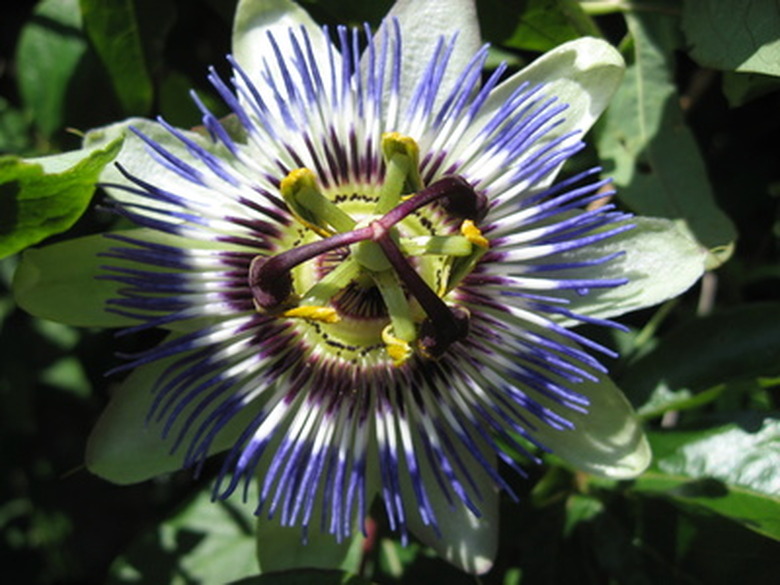Passion Flower Types
Passion flowers (Passiflora) are annual or perennial vines that belong to the Passifloraceae plant family. Most passion flower varieties grow best in moist soils that receive partial to full sunlight. Home gardeners should select passion flowers according to hardiness zone, flower color, mature size and intended use. Various types of passion flowers perform well in American gardens.
Blue Passion Flower
The blue passion flower (Passiflora caerulea) naturally occurs in Argentina and Brazil and typically performs well in United States Department of Agriculture (USDA) Zones 7 to 9. This passion flower variety ranges from 10 to 30 feet in length with spreads up to 6 feet. This annual plant features blue to violet-blue flowers that give way to dark orange fruits in late summer. The blue passion flower prefers loose, gravelly or sandy soils and a location that protects it from harsh winter weather. Caterpillars sometimes feed on the leaves. The blue passion flower works well in large containers and butterfly gardens.
- Passion flowers (Passiflora) are annual or perennial vines that belong to the Passifloraceae plant family.
- Most passion flower varieties grow best in moist soils that receive partial to full sunlight.
Red Passion Flower
The red passion flower (Passiflora coccinea), also called the red granadilla, grows on purple or red stems that reach up to 12 feet in length. Indigenous to Brazil, Peru and Venezuela, this variety performs well in USDA Zones 10 to 12. The vine bears deep red flowers from July through September, followed by edible, yellow to orange fruit. Gardeners often use red passion flowers in hummingbird gardens, containers and butterfly gardens.
Wild Passion Flower
Wild passion flowers (Passiflora incarnate) naturally occur in the Southeastern United States (U.S.) and generally grow well in USDA zones 5 to 9. This vine reaches up to 8 inches in length and 6 feet in diameter. Fragrant flowers bloom from July through September, featuring white petals with purple crowns. These flowers give way to edible, yellow fruit called maypops. Gardeners primarily train wild passion flowers to climb fences, walls and trellises.
- The red passion flower (Passiflora coccinea), also called the red granadilla, grows on purple or red stems that reach up to 12 feet in length.
Corona de Cristo
The corona de Cristo (Passiflora foetida), sometimes called the scarlet-fruit passion flower, is an annual vine that reaches up to 6 feet in length. Flowers bloom from May through October, featuring purple, green or yellow petals that open in the morning and close up again at night. The large, red fruits add ornamental interest to the landscape. Corona de Cristo works well in meadows and as a climbing plant.
Yellow Passion Flower
The yellow passion flower (Passiflora lutea) features green-yellow flowers from May through September, followed by dark purple or black fruit that attract birds and wildlife. The green leaves turn yellow in the autumn. The yellow passion flower vine reaches up to 3 feet in length. This climbing passion flower variety works well in butterfly gardens and bird gardens.
- The corona de Cristo (Passiflora foetida), sometimes called the scarlet-fruit passion flower, is an annual vine that reaches up to 6 feet in length.
- The yellow passion flower (Passiflora lutea) features green-yellow flowers from May through September, followed by dark purple or black fruit that attract birds and wildlife.
Bird Wing Passion Flower
The bird wing passion flower (Passiflora tenuiloba), sometimes called the slender-lobe passion flower or the spread lobe passion flower, naturally occurs in limestone and caliche soils in Texas and New Mexico. This perennial vine matures between 3 and 6 feet in length. Delicate, petal-less, green flowers bloom from April through October. Gardeners often plant bird wing passion flowers in butterfly gardens.
